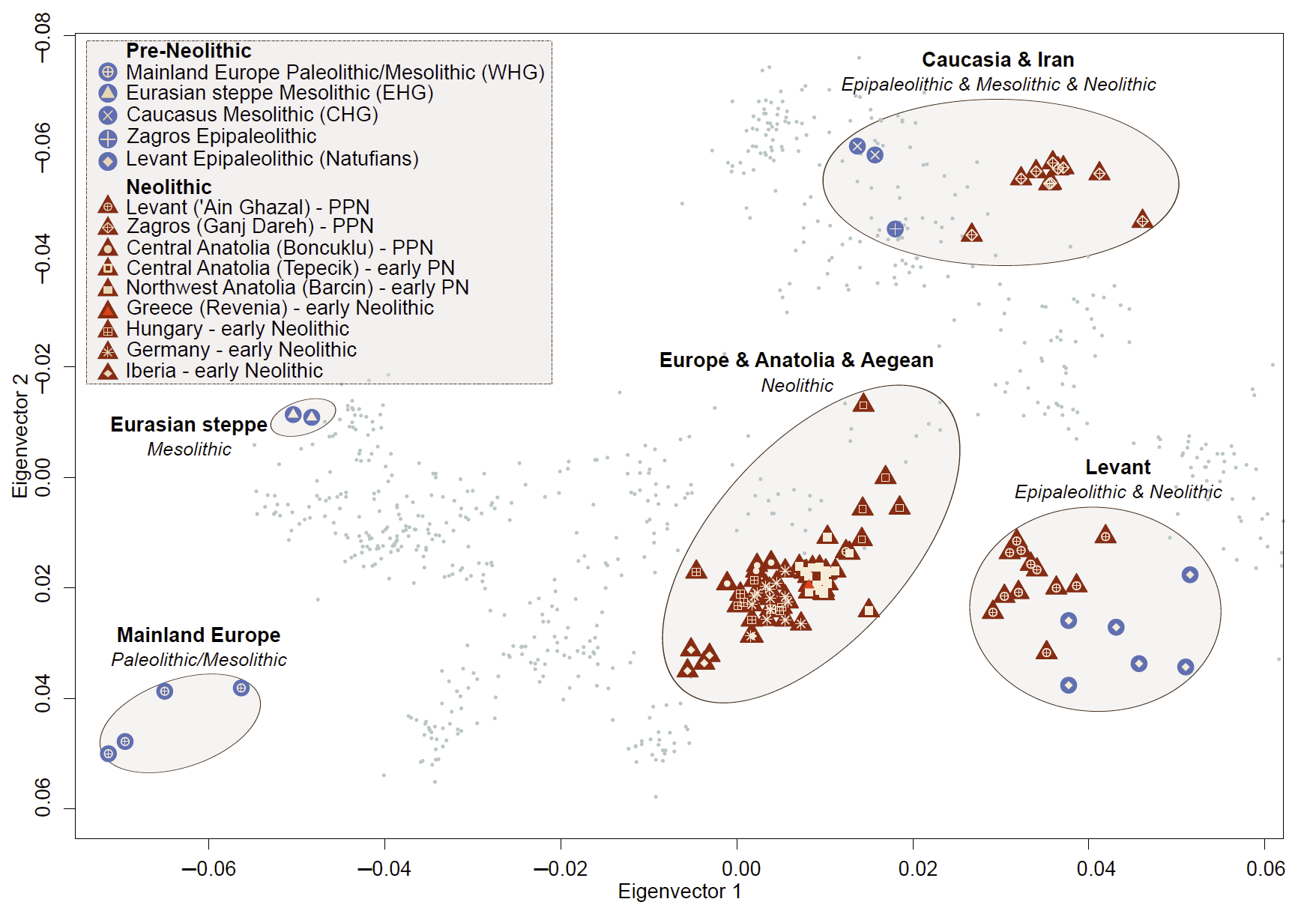Recent paper in Proceedings of the Royal Society B: Archaeogenomic analysis of the first steps of Neolithization in Anatolia and the Aegean, by Kılınç et al. (2017).
Abstract:
The Neolithic transition in west Eurasia occurred in two main steps: the gradual development of sedentism and plant cultivation in the Near East and the subsequent spread of Neolithic cultures into the Aegean and across Europe after 7000 cal BCE. Here, we use published ancient genomes to investigate gene flow events in west Eurasia during the Neolithic transition. We confirm that the Early Neolithic central Anatolians in the ninth millennium BCE were probably descendants of local hunter–gatherers, rather than immigrants from the Levant or Iran. We further study the emergence of post-7000 cal BCE north Aegean Neolithic communities. Although Aegean farmers have frequently been assumed to be colonists originating from either central Anatolia or from the Levant, our findings raise alternative possibilities: north Aegean Neolithic populations may have been the product of multiple westward migrations, including south Anatolian emigrants, or they may have been descendants of local Aegean Mesolithic groups who adopted farming. These scenarios are consistent with the diversity of material cultures among Aegean Neolithic communities and the inheritance of local forager know-how. The demographic and cultural dynamics behind the earliest spread of Neolithic culture in the Aegean could therefore be distinct from the subsequent Neolithization of mainland Europe.
The analysis of the paper highlights two points regarding the process of Neolithisation in the Aegean, which is essential to ascertain the impact of later Indo-European migrations of Proto-Anatolian and Proto-Greek and other Palaeo-Balkan speakers(texts partially taken verbatim from the paper):
- The observation that the two central Anatolian populations cluster together to the exclusion of Neolithic populations of south Levant or of Iran restates the conclusion that farming in central Anatolia in the PPN was established by local groups instead of immigrants, which is consistent with the described cultural continuity between central Anatolian Epipalaeolithic and Aceramic communities. This reiterates the earlier conclusion that the early Neolithisation in the primary zone was largely a process of cultural interaction instead of gene flow.

- The realisation that there are still two possibilities regarding the question of whether Aegean Neolithisation (post-7000 cal BC) involved similar acculturation processes, or was driven by migration similar to Neolithisation in mainland Europe — a long-standing debate in Archaeology:
- Migration from Anatolia to the Aegean: the Aegean Neolithisation must have involved replacement of a local, WHG-related Mesolithic population by incoming easterners. Central Anatolia or south Anatolia / north Levant (of which there is no data) are potential origins of the components observed. Notably, the north Aegeans – Revenia (ca. 6438-6264 BC) and Barcın (ca. 6500-6200 BC) – show higher diversity than the central Anatolians, and the population size of Aegeans was larger than that of central Anatolians. The lack of WHG in later samples indicates that they must have been fully replaced by the eastern migrant farmers.
- Adoption of Neolithic elements by local foragers: Alternatively, the Aegean coast Mesolithic populations may have been part of the Anatolian-related gene pool that occupied the Aegean seaboard during the Early Holocene, in an “out-of-the-Aegean hypothesis. Following the LGM, Aegean emigrants would have dispersed into central Anatolia and established populations that eventually gave rise to the local Epipalaeolithic and later Neolithic communities, in line with the earliest direct evidence for human presence in central Anatolia ca 14 000 cal BCE
- Genetic origins of Minoans and Mycenaeans and their continuity into modern Greeks
- On the origin of R1a and R1b subclades in Greece
- Another nail in the coffin for the Anatolian hypothesis: continuity and isolation in the Caucasus during the Neolithic and Calcholithic, in mtDNA samples
- The over-simplistic “Kossinnian Model”: homogeneous peoples speaking a common language within clearly delimited cultures
On the archaeological evidence (excerpt):
Instead of a single-sourced colonization process, the Aegean Neolithization may thus have flourished upon already existing coastal and interior interaction networks connecting Aegean foragers with the Levantine and central Anatolian PPN populations, and involved multiple cultural interaction events from its early steps onward [16,20,64,74]. This wide diversity of cultural sources and the potential role of local populations in Neolithic development may set apart Aegean Neolithization from that in mainland Europe. While Mesolithic Aegean genetic data are awaited to fully resolve this issue, researchers should be aware of the possibility that the initial emergence of the Neolithic elements in the Aegean, at least in the north Aegean, involved cultural and demographic dynamics different than those in European Neolithization.
Featured image, from the article: “Summary of the data analyzed in this study. (a) Map of west Eurasia showing the geographical locations and (b) timeline showing the time period (years BCE) of ancient individuals investigated in the study. Blue circles: individuals from pre-Neolithic context; red triangles: individuals from Neolithic contexts”.
Related: